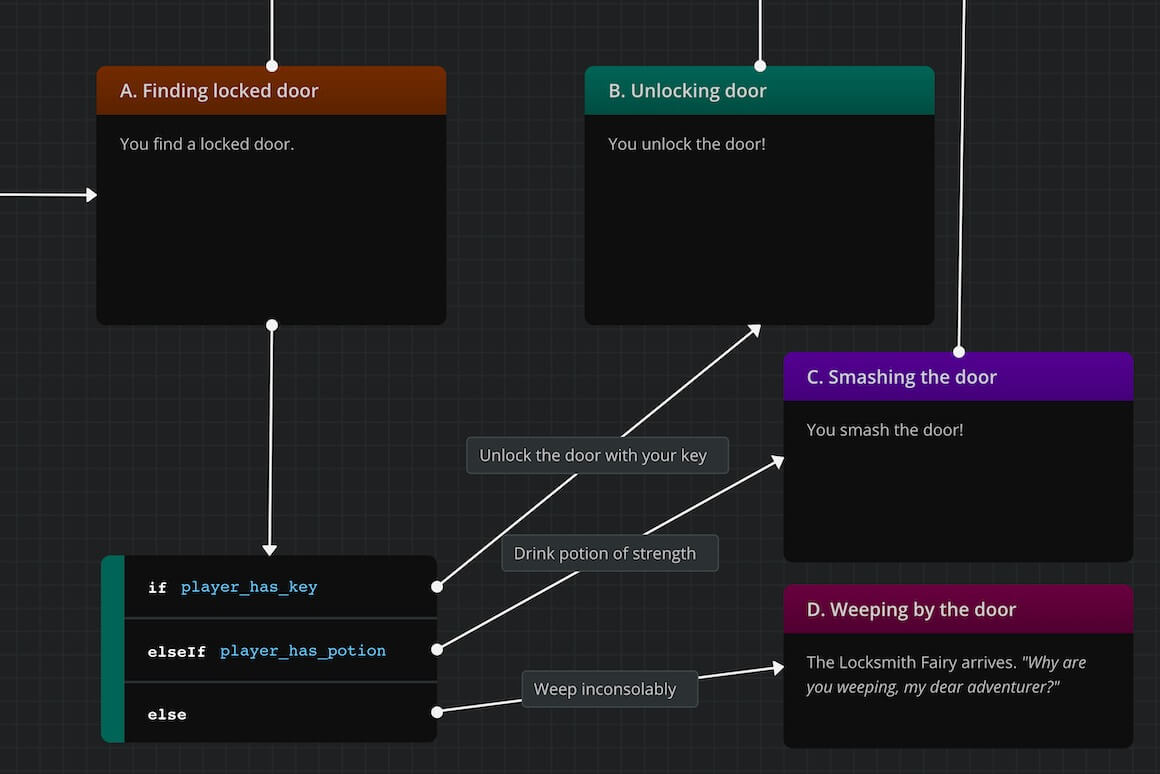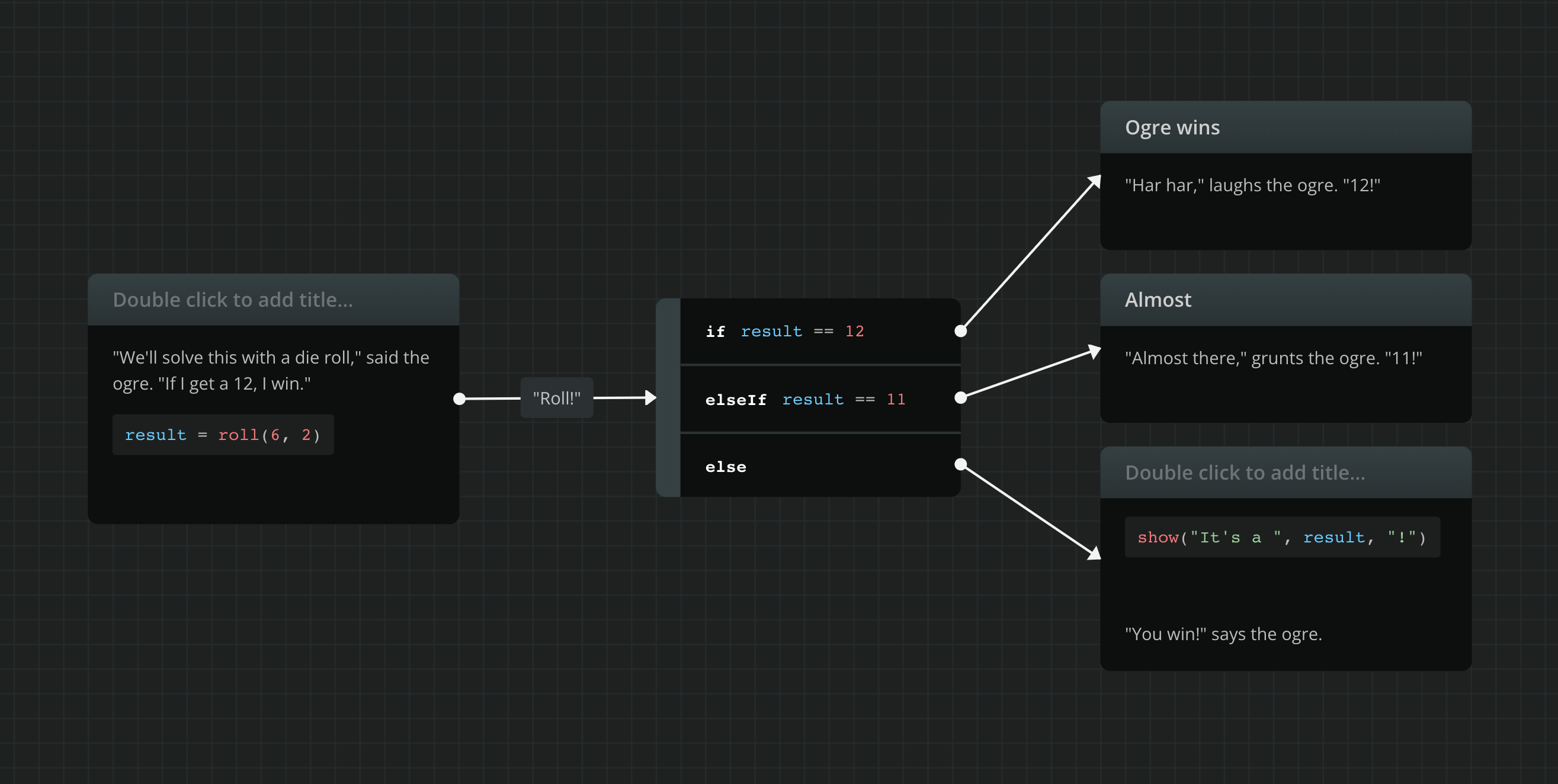Arcscript
Arcweave has its own scripting language, arcscript, with basic scripting capabilities. You can use arcscript in the following two ways:
- As conditions, in branches.
- As segments, in element content and connection labels.
Arcscript in branches
Arcscript is used in branches to control flow with if, elseif, and else conditions.

This page does not cover arcscript in branches; see branches.
Arcscript segments

Arcscript segments are single lines of dialogue that you can add in element content and connection labels. They support assignment and conditional statements.
Add arcscript
To insert an arcscript segment into the content of an element or connection label:
- Double-click the element or label to enter content editing mode.
- Place the cursor on the line where you want to insert the arcscript segment.
- Click the Arcscript segment icon in the formatting toolbar.
- Press Enter to exit the arcscript segment and continue writing in the next line.
✅ You can also toggle an arcscript segment using the shortcut Ctrl/Cmd + Shift + C.
Assignment statements
Assignment statements are of the form of variable = expression. For example:
x = 5
x = y + 5
name = "Tim"
has_key = trueℹ️ To use a variable in an arcscript segment or branch, you must first declare it in Global variables (bottom left of your window).
Arcscript also supports the following operations, with their respective operators:
| Operation | Operator |
|---|---|
| Addition | += |
| Subtraction | -= |
| Multiplication | *= |
| Division | /= |
For example:
x = 5
x += 10
x -= 2Conditional Statements
Conditional statements are of the form: if.../elseif.../else/endif. Inside conditional statements, you may have:
- other statements (assignments or conditionals).
- text content.
Example of a conditional statement containing an assignment:
if x == 5
y = 4
endifExample of a conditional statement containing some text content:
if wielding_shield
The knight is wielding a large shield.
endifExample of a conditional statement containing some text content and a variable assignment:
if hasKey
You unlock the door!
doorUnlocked = true
else
You cannot open the door
endifExample of using elseif for multiple outcomes:
if age >= 18
Look at you! All grown up!
type = "adult"
elseif age > 0
You are not an adult yet.
type = "child"
else
Are you sure you have been born?
type = "unborn"
endifExpressions
Arcsript supports the creation of expressions using the following arithmetic operators: +, -, *, / and (, ). Expressions may combine literals, function calls and variables.
Conditions
Conditions in Arcscript may be formed by using the following conditional operators: == (or is), != (or is not), >, >=, <, <=.
Combining conditions may be achieved by using the following logical operators: && (or and), || (or or), ! (or not).
Built-in functions
The functions that are currently supported in Arcscript:
| Function | Returns |
|---|---|
abs(n) | The absolute value of a number |
sqr(n) | The square of a number |
sqrt(n) | The square root of a number |
min(n1, n2, ...) | The minimum of a series of numbers |
max(n1, n2, ...) | The maximum of a series of numbers |
random() | A random decimal between (and including) 0 and (excluding) 1, i.e. in [0, 1) |
reset(v1, v2, ...) | Has no return value - resets the given variables to their initial value |
resetAll(v1, v2, ...) | Has no return value - resets all variables, except the given ones, to their initial value |
roll(m, n) | A roll of an (n) number of (m)-sided dice (see below) |
round(n) | The number rounded to the nearest integer |
show(e1, e2, ...) | The evaluation and concatenation of its argument expressions (see below) |
visits(el) | The number of visits in a certain element |
roll

The roll(m, n) function simulates polyhedral die rolls from the classic tabletop RPGs.
Roll takes 2 integer numbers as its arguments:
m: the number of sides of the rolled die.n: the number of dice rolled.
The function returns a random integer between (and including both) n and n*m, i.e. [n, n*m].
✅ If
n = 1, you can omit the second argument and simply typeroll(m).
For example, rolling for a number from 1 to 12:
damage = roll(12)Example of rolling 3d6 (3 six-sided dice) for a character's ability scores in Dungeons & Dragons:
dexterity = roll(6, 3)Example of a dynamic use, where the player suffers damage from 1 to max_damage:
player_hp = player_hp - roll(max_damage)But the roll(m, n) function can also be used in a conditional statement:
if roll(max_damage) > player_hp
Oops... This isn't good...
endifshow
The show(e1, e2, ...) function renders its arguments and concatenates them as one string.
For example, the following:
show("Your score is ", score, "/", max_score, ".")... for score == 3 and max_score == 256 returns:
> Your score is 3/256.
You can use the show(e1, e2, ...) function in combination with text content, in elements. For example:
if roll(max_damage) > player_hp
Oops... This isn't good...
You have died. In this game you scored
show(score, " out of ", max_score, ".")
endifvisits
Call visits() with an element argument
The visits(element) function returns the number of times a specific element has been visited during the current playthrough.
The element argument must be a mention to an element. To mention an element inside visits():
- Place your cursor within the parentheses of
visits(). - Type
@and begin entering the element's title. - Select the correct element from the autocomplete list.
✅ Mentioning an element in arcscript works similarly to mentioning a component or board in rich text fields.
Call visits() without an argument
If visits() is called without an argument, it implicitly refers to the most recently loaded element in the flow. This means one of the two following cases:
– When used inside an element's content, it refers to that element itself. – When used inside a connection label, it refers to the element that was visited immediately before.
Examples
The knight is guarding a mysterious gate. You see a name written above his head:
| "Conrad IV, Count of Exeter"
if visits(examine_the_painting) > 1
You make a mental note of the knight's name.
endifAnd if we are already in the Examine the painting element, we can write:
The knight is guarding a mysterious gate. You see a name written above his head:
| "Conrad IV, Count of Exeter"
if visits() > 1
You make a mental note of the knight's name.
endifErrors
When a script has a compile-time error, this is denoted by an exclamation mark symbol, at the lower right corner of the container element.
✅ Hover your mouse cursor over the symbol to get more info on what the error is about.